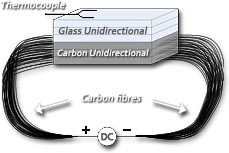Development and testing of self-deformed composites
 A multifunctional composite without insertion of actuators can be developed by exploiting the thermal anisotropy of a composite laminate in order to induce shape changes by internal heating. Indeed a selective thermal activation of one or more layers inside the material would create thermal stresses, which could induce shape change to the material at the macroscopic level, just as those observed in the bimetallic strips.
A multifunctional composite without insertion of actuators can be developed by exploiting the thermal anisotropy of a composite laminate in order to induce shape changes by internal heating. Indeed a selective thermal activation of one or more layers inside the material would create thermal stresses, which could induce shape change to the material at the macroscopic level, just as those observed in the bimetallic strips.
In the classical composite laminate case, each lamina can have a different Young modulus and a different thermal expansion coefficient. When the temperature is increased due to the mismatch of the thermal expansion coefficients each lamina will elongate to a different extend and if the bonding is perfect, the structure will have to bend. Thus one can design composite laminates that undergo control bending by either internal (or external) heating without adding or integrating actuators or other devices.
We have developed and tested a new method for controlling shape changes in composites by means of heating up the reinforcing fibres of the composite. The proposed method represents a significant improvement because in most high performance applications for which multifunctionality is required, carbon fibres are the main reinforcing agents and therefore there is no need to add a bundle of dry fibres or a metal plate to heat up the composite. As shown in the figure, individual carbon fibres can be pulled out from the edges of constituent fabrics prior to lamination so as to fabricate the necessary electrical connections for current flow on the completion of autoclave lamination procedure. The resulting shape change can be determined and the stresses generated during heating were measured via a 3-point bending device.
Researchers involved:
• George Trakakis
Relevant Publications:
- "Development and Testing of a Self-Deformed Composite Material" by G. Trakakis and C. Galiotis (Submitted for Publication)
